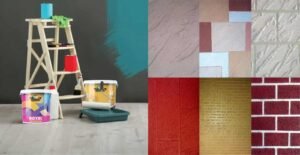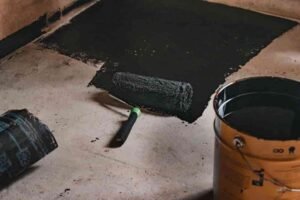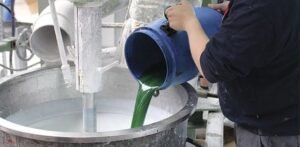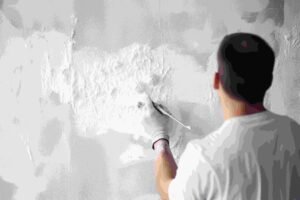Introduction to Textures
Mithila Paints is a distinguished name in the paint industry, known for its rich legacy and unwavering commitment to quality. Established several decades ago, the company has continuously evolved, embracing innovative approaches that resonate with both tradition and modernity. With a vision to enhance spaces through beautiful and durable paint solutions, Mithila Paints has carved a niche for itself as a trusted provider of high-quality products.
The core mission of Mithila Paints revolves around delivering superior paint solutions that meet the diverse needs of its customers. This commitment is evident not only in the products themselves but also in the manufacturing process, which emphasizes sustainability, safety, and environmental awareness. The company takes pride in utilizing advanced technology and innovative techniques to produce a wide range of textures and paint finishes, ensuring that every product meets stringent industry standards.
Mithila Paints’ values are central to its operations, fostering a culture of excellence, creativity, and responsibility. The company believes in the power of colors and textures to transform spaces, contributing positively to the aesthetic appeal of homes and businesses alike. By focusing on research and development, Mithila Paints stays ahead of the curve, continuously introducing innovative textures and formulations that cater to the latest trends and customer preferences.
This dedication to innovation and quality sets the foundation for the intricate manufacturing processes that lie at the heart of the company’s offerings. Each texture crafted by Mithila Paints reflects not only artistic vision but also scientific precision, ensuring a harmonious balance between functionality and aesthetics. Understanding the meticulous nature of this process will enhance our appreciation for the artistry involved in creating these exceptional paint products.
Understanding Texture in Paint
Texture in the context of paint refers to the visual and tactile quality of a painted surface that influences both aesthetics and functionality. In the realm of manufacturing, specifically within the painting industry, texture plays a pivotal role in the overall perception and application of paint products. It encompasses a variety of finishes, from smooth and glossy to rough and matte, each imparting unique characteristics that can enhance or alter a space’s ambiance.
The significance of texture extends beyond mere aesthetics; it can also impact the paint’s performance. For instance, textured paints can provide added durability and resistance to wear in high-traffic areas. They can also play a part in mold and mildew resistance, making them suitable for environments like bathrooms and kitchens. Moreover, the right texture can improve the acoustic properties of a room, aiding in sound absorption.
There are several types of textures commonly found in paint products. These include standard finishes such as flat, eggshell, satin, semi-gloss, and high-gloss, each applicable to different surfaces and desired effects. Additionally, specialized textures can be achieved through techniques such as stucco, sand, or knockdown, which further broaden the possibilities in decorative and protective applications. Understanding these variations allows manufacturers to tailor their offerings to specific market needs and consumer preferences.
In various environments, such as residential, commercial, or industrial settings, the choice of texture can significantly influence both the aesthetic appeal and functional performance of the paint. Ultimately, an appreciation for texture in paint manufacturing not only enriches artistic expression but also meets the practical requirements of diverse applications, forming an essential foundation for further advancements in the industry.

Raw Materials Used in Textures Production
At Mithila Paints, the creation of textured paints is a meticulous process that begins with the selection of high-quality raw materials. Each component plays a vital role in determining the paint’s texture, application properties, and overall durability. The primary raw materials used in the production of textured paints include pigments, binders, and fillers.
Firstly, pigments are crucial for imparting color and opacity to the textured paints. These finely milled particles not only provide the desired hue but also enhance the paint’s resistance to fading from exposure to sunlight. Mithila Paints utilizes a range of pigments derived from both organic and inorganic sources, ensuring that the colors are vibrant and long-lasting. The choice of pigments affects the final aesthetic and functional properties of the paint, making their selection a key step in the manufacturing process.
Secondly, binders are essential for adhering the pigments and fillers together, forming a cohesive paint film upon application. Viscosity and adhesion are significantly influenced by the type and quality of the binder used. Mithila Paints opts for polymer-based binders in its formulations, as they contribute to the flexibility and weather resistance of the paint, making it suitable for diverse applications. These binders ensure that the textures created remain intact over time, regardless of environmental conditions.
Lastly, fillers complement the textural aspect of the paint, providing bulk and affecting the paint’s finish and consistency. The addition of fillers enhances the structural integrity of the paint, allowing for varied textures—from coarse to fine. Mithila Paints incorporates natural and synthetic fillers that not only achieve the desired texture but also improve the paint’s overall performance characteristics, such as coverage and durability.
Incorporating these raw materials with precision is fundamental to producing quality textured paints. The balance of pigments, binders, and fillers ultimately culminates in a textured paint that meets the high standards expected by customers.

The Textures Manufacturing Process: An Overview
The manufacturing process for textured paints at Mithila is a sophisticated blend of artistry and technical precision, ensuring the creation of high-quality products. This process initiates with formulation, where skilled technicians develop specific paint recipes. These formulations are meticulously designed to include a variety of materials, ensuring that the final product meets both aesthetic and performance criteria. At this stage, factors such as color, texture intensity, and finish type are critically analyzed to align with market demands and customer preferences.
Once the formulations are developed, the next phase is mixing. This step involves combining the ingredients in precise measurements to achieve a homogenous mixture. Advanced machinery is employed to facilitate this process, enabling efficient blending of pigments, binders, and additives. The mixing phase is crucial, as it ensures that the desired texture and color are uniformly distributed throughout the paint. Vigilance during this stage is paramount, as improper mixing can lead to inconsistencies in the final product.
Following mixing, the milling process takes precedence. Here, the mixture is subjected to mechanical forces which refine the particle size and enhance texture distribution. The milling equipment employed at Mithila allows for various degrees of granularity, tailoring the texture as per product specifications. This intensive stage is integral to developing the unique textures associated with Mithila paints, providing the distinct finish that customers cherish.
Finally, the textured paints undergo a thorough quality control assessment before packaging. Rigorous testing ensures that the paints not only meet aesthetic criteria but also comply with safety and performance regulations. Each batch is carefully inspected to preserve the integrity of the textures intended for delivery. Upon passing quality checks, the paints are efficiently packaged, ready for distribution. This diligent process underscores the commitment of Mithila Paints to quality, addressing both the art and science behind textured paint manufacturing.

Quality Control Measures in Texture Manufacturing
Mithila Paints places a paramount emphasis on quality control throughout the texture manufacturing process, ensuring that each product meets the highest standards of consistency and reliability. The approach is comprehensive, covering various stages from raw material selection to the final inspection of textured products. With a commitment to excellence, the company employs rigorous testing protocols designed to assess not only the aesthetic qualities but also the functional aspects of its offerings.
One of the critical components of quality assurance at Mithila Paints is the selection of quality raw materials. These materials undergo a stringent assessment before being utilized in the production process. Each batch is tested for its chemical composition and physical properties, which helps in maintaining uniformity in texture application. This step is vital in developing reliable textured finishes that customers can trust.
In terms of equipment, Mithila Paints is equipped with advanced testing apparatus specifically designed to evaluate the performance of textured finishes. Rigorous tests including adhesion tests, viscosity measurements, and weather resistance assessments allow the team to identify any potential discrepancies early in the manufacturing cycle. By utilizing state-of-the-art technology, the company not only enhances the durability of its products but also aligns with industry best practices.
Moreover, routine inspections are an integral part of the quality control framework at Mithila Paints. Quality inspectors conduct thorough evaluations at various production stages, ensuring that each textured product adheres to predetermined specifications. By incorporating ongoing training for staff in quality assessment techniques, Mithila Paints cultivates a culture of accountability and diligence within its workforce. This proactive attitude towards quality control allows for swift identification and rectification of any non-conformities, ultimately safeguarding the quality of textured products on the market.

Innovations in Textures Production at Mithila
Mithila Paints has emerged as a frontrunner in the textures manufacturing industry by seamlessly integrating cutting-edge technologies and innovative techniques into its production processes. At the core of its advancements is a commitment to research and development, which has led to the creation of unique formulations that enhance both the aesthetic appeal and performance of its texture products.
One of the key innovations at Mithila Paints is the utilization of eco-friendly materials that do not compromise on quality. This approach not only meets evolving consumer demands for sustainable options but also adheres to environmental regulations, significantly reducing the ecological footprint associated with texture manufacturing. The formulation of these materials has been meticulously researched, focusing on high durability and resistance to external factors, ensuring that the textures maintain their integrity over time.
Additionally, Mithila has invested heavily in modern machinery that optimizes the production process. Automated mixing and application techniques enable a more consistent texture output, reducing waste and improving efficiency. The integration of digital technology in monitoring production lines has also allowed for real-time adjustments and quality control, facilitating the seamless production of high-quality textured finishes.
Furthermore, the company’s emphasis on collaboration with industry experts and research institutions has led to breakthrough innovations in texture design. By exploring new aesthetic trends and combining traditional craftsmanship with contemporary methods, Mithila Paints continues to set benchmarks in the industry. These innovations not only enhance the performance of their products but also elevate customer experience by offering a diverse range of textures that cater to various architectural styles.
Overall, Mithila Paints’ commitment to innovation in textures production speaks to their dedication to delivering superior products while staying ahead of market trends and customer expectations.

Sustainability Practices in Manufacturing Textures
Mithila Paints actively embraces sustainability in its textures manufacturing process, reflecting a commitment to eco-friendly practices that minimize environmental impact. Central to these efforts is the use of sustainable materials. The company prioritizes ingredients that are sourced from renewable resources, thereby ensuring that their production processes do not deplete natural reserves. By opting for eco-conscious raw materials, Mithila Paints not only enhances the quality of its textures but also contributes to a healthier ecosystem.
Waste management is another crucial aspect of Mithila Paints’ sustainability strategy. The company has implemented rigorous strategies aimed at reducing waste generated during the manufacturing process. This includes recycling excess materials and repurposing production by-products. By reclaiming resources that would otherwise be discarded, Mithila Paints effectively reduces its overall waste footprint and promotes a circular economy within the manufacturing sector.
In addition to sustainable materials and waste management, Mithila Paints actively seeks to reduce the environmental impact of its production through energy efficiency initiatives. The company has adopted advanced technologies that require less energy, thus decreasing greenhouse gas emissions associated with manufacturing textures. Furthermore, Mithila Paints invests in renewable energy sources, such as solar power, further bolstering its commitment to sustainable practices.
Lastly, Mithila Paints remains dedicated to continuous improvement in its sustainable practices. The company regularly conducts assessments to identify additional areas for sustainability enhancements. By encouraging innovation and engaging in collaborative projects with environmental partners, Mithila Paints aims to lead the way in environmentally responsible manufacturing within the industry. Through these comprehensive efforts, Mithila Paints exemplifies the integration of sustainability within the art and science of textures manufacturing.

Application Techniques for Textured Paints
When it comes to applying textured paints, professionals utilize a variety of techniques that significantly impact the final finish. Mithila Paints offers a selection of textured finishes that can be expertly applied through different methods, each suited for specific aesthetic outcomes. Understanding these techniques is essential for achieving optimal results.
One widely used method involves the use of a roller, which is ideal for larger surfaces. The roller allows for even distribution of the textured paint, creating a uniform pattern. For a more pronounced texture, a thick nap roller is recommended. This tool provides deeper troughs in the paint, resulting in a more dramatic finish. Alternative approaches include using brushes or sponges, which can add unique textures. A dry brush technique can create a subtle layered effect, while sponging can introduce a more organic appearance.
Another effective application technique is the flicking method, where a brush is flicked against the surface to impart a stippled effect. This technique requires a steady hand and can be adjusted based on the level of texture desired. For intricate designs, stencils can be utilized, allowing for greater artistic freedom while maintaining consistent textures.
To ensure optimal results, professionals recommend preparing the surface adequately before applying the paint. This process includes cleaning and priming, which not only enhances adhesion but also contributes to a smoother final appearance. Additionally, the environment plays a significant role; factors such as temperature and humidity can affect drying times and the overall finish. Therefore, it is crucial to consider these conditions when planning the application of textured paints.
By using the right tools and techniques, along with careful preparation, professionals can harness the transformative power of Mithila’s textured paints to create stunning visual effects that enhance any space.

Conclusion: The Future of Textures at Mithila Paints
As we reflect on the key points discussed regarding the art and science of texture manufacturing at Mithila Paints, it is evident that the company is well-positioned to navigate the evolving landscape of the paint industry. The textures market is continuously changing, influenced by emerging design trends, innovations in technology, and shifting customer preferences. Mithila Paints has demonstrated its commitment to remaining at the forefront of these developments by prioritizing quality, sustainability, and aesthetic appeal in their product offerings.
With a focus on consumer desires for personalization and unique finishes, Mithila Paints aims to cater to a diverse clientele seeking to enhance their living spaces. The incorporation of rich textures not only elevates the aesthetic quality of residences and commercial spaces but also addresses practical considerations such as durability and ease of maintenance. As manufacturers adapt to the growing demand for environmentally friendly solutions, Mithila Paints is exploring sustainable materials and processes that align with its long-standing commitment to ecological responsibility.
Looking ahead, coping with advanced technologies will be crucial. Innovations in application techniques, combined with research into novel materials, are likely to redefine the textures landscape. Mithila Paints is embracing these advancements, creating products that meet the modern consumer’s expectations and preferences. By fostering collaborations with designers and architects, the company is not only enhancing its creative capabilities but also ensuring that its textures resonate with contemporary design paradigms.
Ultimately, Mithila Paints is strategically positioned to adapt to future challenges and opportunities within the textures market. By maintaining its dedication to quality and innovation, the company is set to lead the way in crafting exquisite textures that reflect the spirit of its customers. The future of textures at Mithila Paints promises creativity, sustainability, and unmatched quality, setting new standards in the paint industry.

